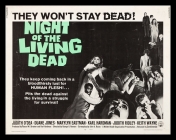
Arguably one of the biggest influences on modern horror outside of “The Exorcist” is zombie fiction. As a theme, zombies have transcended almost every genre: action, black comedy, historical fiction and even romance. They’ve also managed to break into almost every single representation of media that is widely used. Movies, video games, television, comic books and countless others have all tapped into zombies at some point, either as a side-dish or a main course that fuels the central plot. And what popularized zombie fiction you may ask? Why, George Romero’s 1968 horror classic “Night of the Living Dead,” of course.
The story is very simple. The dead have begun coming back to life for reasons unknown to the main characters and they board themselves up in a country house to try and escape the undead. However, like with most great movies, this seemingly simple storyline unfolds to reveal a plethora of hidden themes and ideas barely obscured by the pretext of a fun premise for a scary movie.
Good horror taps into something real using fiction as an allegory for real-world issues. In this case, it is the fact that humans and zombies have a lot more in common than we would like to admit. When they’re forced to, both people and zombies will devour each other. The zombies do this by eating flesh, but humans do it through cowardice, self-preservation and prejudice. It’s no mystery then why Ben (Duane Jones) is chosen as the protagonist. An African-American male as the protagonist in a Civil Rights era film is about as overt as one can get. How can we call zombies monsters when we kill each other just as senselessly?
George Romero’s direction and cinematography are nothing special, but to be honest, who cares? This is a zombie film, not a Stanley Kubrick piece. It doesn’t have to be special or revolutionary, just functional.
The cast is surprisingly good, especially for an independent horror film. As you probably could have guessed, Duane Jones anchors the film the best as the protagonist, and in the illustration of the central themes of the film. Karl Hardman gives the other excellent performance as Harry Cooper, the cowardly father who does what most of us would try and do in his situation – look after his family even at the cost of others.
The last question that could be asked about the film is this: is it scary? Yes, it is extremely scary. Romero’s cinematography is still nothing special, but he nails the feeling of claustrophobia that is necessary to communicate just how trapped these people are.
Overall, there are little negatives to point out in this film. Seeing this movie is less about whether or not it’s good — it’s more about whether or not you want to miss out on a piece of history.





